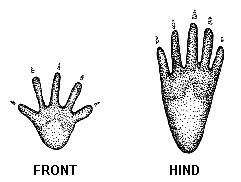British Columbia Outdoor Wilderness Guide  |

Raccoons
Procyon lotor
Description
- The raccoon is a reddish-brown above and black
or greyish below. The most prominent characteristics
are the bushy tail with 4-6 black or brown rings and
the black mask outlined in white. The ears are small
and the feet and forepaws are dexterous.
Distribution
- This animal is native to the southern part of the
Canadian provinces and most of the United States. It
is most common along stream edges, open forests and
coastal marshes.
Biology - The raccoon inhabits hollow trees and logs
for homes and often use the ground burrows of other animals
for raising their young or for sleeping during the coldest
part of the winter months. An average of 4-5 young are
born in April-May; the mother at first carries them by
the nape of the neck like a cat; they are weaned by late
summer. Omnivorous, it feeds on grapes, nuts, grubs, crickets,
small mammals, birds' eggs and nestlings. Often seen washing
their food, the raccoon is actually feeling for matter
that should be rejected as the wetting of the paws enhances
its sense of feel. Winter is the raccoons greatest enemy
when food is scarce.
 Tracks - The tracks of the raccoon are paired,
having one rear foot beside one front one. The raccoon
has five toes and usually the claw marks are evident
in the print. The hind foot makes a print in which the
toes and heel pad are joined whereas the front tracks
toe and heel pad have a brief space between. The print
vaguely resembles that of a miniature bear.
Tracks - The tracks of the raccoon are paired,
having one rear foot beside one front one. The raccoon
has five toes and usually the claw marks are evident
in the print. The hind foot makes a print in which the
toes and heel pad are joined whereas the front tracks
toe and heel pad have a brief space between. The print
vaguely resembles that of a miniature bear.
Straddle: 10 - 13 cm (4 - 5.2 in)
Stride: 15 - 40 cm (6 - 16 in)
Track: Front - Front - 7 cm (2.8 in) long / 7 cm (2.8
in) wide
Track: Rear - 10 cm (4 in) long / 6 cm (2.4 in) wide
|
|


 Tracks - The tracks of the raccoon are paired,
having one rear foot beside one front one. The raccoon
has five toes and usually the claw marks are evident
in the print. The hind foot makes a print in which the
toes and heel pad are joined whereas the front tracks
toe and heel pad have a brief space between. The print
vaguely resembles that of a miniature bear.
Tracks - The tracks of the raccoon are paired,
having one rear foot beside one front one. The raccoon
has five toes and usually the claw marks are evident
in the print. The hind foot makes a print in which the
toes and heel pad are joined whereas the front tracks
toe and heel pad have a brief space between. The print
vaguely resembles that of a miniature bear.